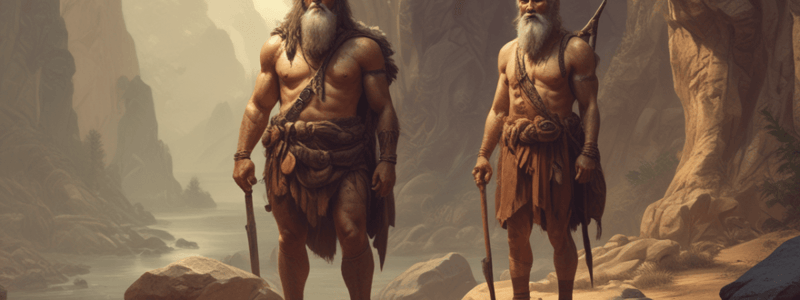Podcast
Questions and Answers
Which of the following is a characteristic of the Mesolithic period?
Which of the following is a characteristic of the Mesolithic period?
- Establishment of permanent settlements
- Use of more sophisticated tools (correct)
- Development of agriculture
- Creation of writing systems
What was a key characteristic of the Renaissance?
What was a key characteristic of the Renaissance?
- Expansion of feudalism
- Increased religious authority
- Rise of industrialization
- Revival of classical Greek and Roman culture (correct)
Which event marked the end of the Western Roman Empire?
Which event marked the end of the Western Roman Empire?
- The Crusades
- The Renaissance
- The Industrial Revolution
- The Fall of the Roman Empire (correct)
Flashcards are hidden until you start studying
Study Notes
Prehistory
- Refers to the period before written records of human history
- Divided into three main periods:
- Paleolithic (Old Stone Age): Early humans developed tools, hunted, and gathered food (c. 2.5 million - 10,000 BCE)
- Mesolithic (Middle Stone Age): Humans developed more sophisticated tools, began to settle in permanent locations (c. 10,000 - 5,000 BCE)
- Neolithic (New Stone Age): Humans developed agriculture, domesticated animals, and established permanent settlements (c. 5,000 - 2,000 BCE)
Ancient Civilizations
- Mesopotamia (modern-day Iraq): Developed writing (c. 3,500 BCE), established city-states, and created laws (e.g., Code of Hammurabi)
- Ancient Egypt (modern-day Egypt): Developed hieroglyphics, built pyramids, and had a complex system of government and religion (c. 3,100 - 300 BCE)
- Ancient Greece (modern-day Greece): Contributed significantly to Western philosophy, theater, and democracy (c. 8th century - 146 CE)
- Ancient Rome (modern-day Italy): Established a vast empire, developed a system of laws, and made significant contributions to architecture and engineering (c. 8th century BCE - 476 CE)
Medieval Period
- Fall of the Roman Empire (476 CE): Marked the end of the Western Roman Empire and the beginning of the Middle Ages
- Feudalism: A social system in which lords owned land and vassals provided military service in exchange for protection and land
- Crusades: A series of military campaigns launched by European Christians to reclaim the Holy Land from Muslim rule (1095-1291)
Early Modern Period
- Renaissance (14th-17th centuries): A cultural and intellectual movement that marked a revival of classical Greek and Roman culture
- Age of Exploration (15th-17th centuries): European explorers, such as Christopher Columbus, discovered new lands and established trade routes
- Reformation (16th century): A religious movement that led to the division of Christianity into Protestantism and Catholicism
Modern Period
- Industrial Revolution (18th-19th centuries): A period of significant economic, technological, and social change marked by the development of factories and machines
- World War I (1914-1918): A global conflict that involved many nations and led to significant loss of life and widespread destruction
- World War II (1939-1945): A global conflict that involved many nations and led to significant loss of life, widespread destruction, and the formation of the United Nations
Contemporary Era
- Cold War (1945-1991): A period of political and military tension between the United States and the Soviet Union
- Globalization (late 20th century-present): A process of increasing economic and cultural interconnectedness among nations
- Digital Age (late 20th century-present): A period marked by the widespread use of computers, the internet, and other digital technologies
Prehistory
- Prehistory encompasses the era before written records of human existence.
- Divided into three main periods:
- Paleolithic (Old Stone Age): Earliest humans used rudimentary tools, primarily hunted and gathered (c. 2.5 million - 10,000 BCE).
- Mesolithic (Middle Stone Age): Featured advanced tool-making and the beginnings of permanent settlements (c. 10,000 - 5,000 BCE).
- Neolithic (New Stone Age): Marked by the advent of agriculture, animal domestication, and established communities (c. 5,000 - 2,000 BCE).
Ancient Civilizations
- Mesopotamia: Known for the creation of writing around 3,500 BCE, development of city-states, and the formulation of laws (e.g., Code of Hammurabi).
- Ancient Egypt: Renowned for hieroglyphics, monumental pyramids, and a complex governance and religious system (c. 3,100 - 300 BCE).
- Ancient Greece: Key contributions to Western philosophy, theater, and the concept of democracy (c. 8th century - 146 CE).
- Ancient Rome: Established a large empire, advanced legal systems, and made notable contributions to architecture and engineering (c. 8th century BCE - 476 CE).
Medieval Period
- Fall of the Roman Empire in 476 CE led to the onset of the Middle Ages.
- Feudalism: A societal structure where lords owned land, and vassals offered military service in return for protection and land.
- Crusades: Military campaigns by European Christians aimed at reclaiming the Holy Land from Muslim control (1095-1291).
Early Modern Period
- Renaissance (14th-17th centuries): A resurgence of classical Greco-Roman culture, emphasizing art and intellectual growth.
- Age of Exploration (15th-17th centuries): Notable explorers, including Christopher Columbus, discovered new territories and established trade networks.
- Reformation (16th century): A pivotal movement that divided Christianity into Protestantism and Catholicism, impacting religious and political landscapes.
Modern Period
- Industrial Revolution (18th-19th centuries): Characterized by profound economic and technological transformation, including the rise of factories and machine production.
- World War I (1914-1918): A significant global conflict that resulted in massive loss of life and extensive destruction across nations.
- World War II (1939-1945): A worldwide conflict with vast casualties and destruction, leading to the establishment of the United Nations.
Contemporary Era
- Cold War (1945-1991): A tense political and military rivalry between the United States and the Soviet Union, influencing global politics.
- Globalization (late 20th century-present): The increasing economic and cultural integration among nations around the globe.
- Digital Age (late 20th century-present): Defined by the widespread usage of computers and the internet, revolutionizing communication and information access.
Studying That Suits You
Use AI to generate personalized quizzes and flashcards to suit your learning preferences.




